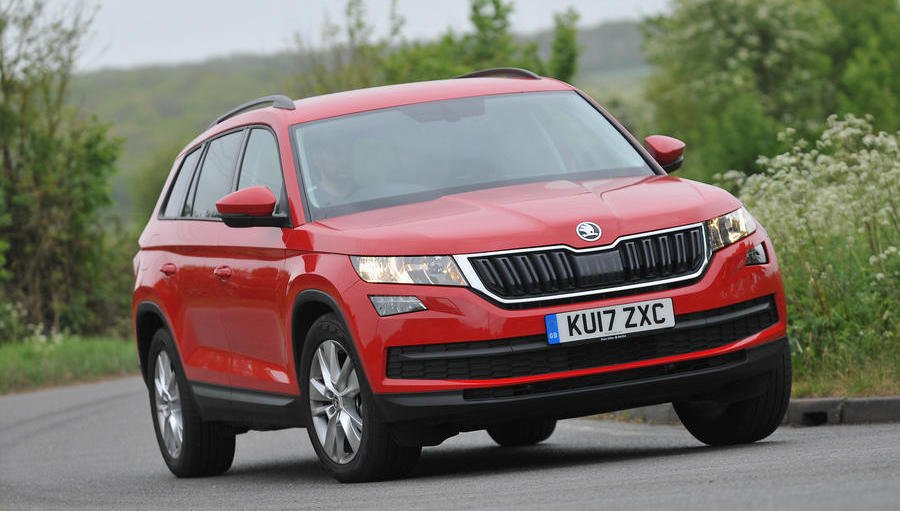Fashion-conscious families after an affordable seven-seat SUV could do a lot worse than check out the popular Skoda Kodiaq. Since its launch in 2017, it has established itself as ideal transport for families on a tight budget, blending punch with economy and generous space with decent running costs.
Most buyers so far have opted for the 148bhp 2.0-litre diesel, which is gutsy enough to haul around seven people with little drama and more economical (on paper) when fitted with the DSG automatic gearbox than it is when specified as a six-speed manual. For those who need a little extra poke, the 2.0 TDI 190 packs 188bhp. There are some petrol options, too, beginning with the entry-level 123bhp 1.4 TSI 125, which actually copes reasonably well in a vehicle this big.
But if you intend to drive long distances or frequently travel fully loaded with people and paraphernalia, the 148bhp 1.4 TSI 150 petrol is a better bet. In 2018, this engine was replaced by a 1.5 TSI 150 unit with lower emissions that provides similarly eager performance and good economy. The 2.0 TSI is the strongest petrol option, but it’s a rare sight on UK roads.
Trims start with entry-level S, which is a little sparsely equipped and available with only five seats, rather than seven. Next-up SE provides dual-zone climate control, rear parking sensors, automatic lights and wipers, a decent infotainment system and cruise control. The SE L trim above that adds sat-nav and adaptive LED headlights, Alcantara seats, keyless entry and start and a powered tailgate. The upper levels, SE Tech and Edition, while fulsomely equipped, are a little pricey on the used-car forecourts.
The Kodiaq handles well, with a surprising amount of agility for something so commodious, and it has plenty of grip. It rides well, too, although there’s a slightly unsettled nature to the car around town, over potholes and across road imperfections. It’s also pleasingly refined, regardless of which engine you choose. Wind and road noise are low around town but can be a touch too much at higher speeds.
But it’s inside where the Kodiaq starts to flex its muscles. The driving position is excellent, with good visibility, and the dashboard and all the surrounding areas are full of soft- touch materials and well-damped switches. There’s also a logical and easy-to-use 8.0in touchscreen infotainment system that comes with smartphone mirroring.
Space up front is excellent, too, while the second row of seats will happily accommodate three passengers. The rearmost row has enough space for two children that don’t require child seats, but adults will only be comfortable for short journeys. These seats fold away easily for increased boot space, and the boot becomes cavernous with all the rear seats folded down. Boot space, with the second row in place, is good, even though some of the Kodiaq’s larger rivals offer a little more capacity.
Need to know
Prices range from £17,000 for a 2016 or 2017 Kodiaq to £22,000 to £28,000 for models from 2020 on.
The most economical engine is the 2.0 TDI 150 diesel, which, when equipped with a DSG auto gearbox, returns a WLTP rating of 46.3mpg.
The diesel Kodiaq finished in sixth place out of 22 cars in the large SUV class in our sister title What Car?’s latest Reliability Survey, while petrols came 12th.
Buyer Beware
Engine: Failure to use your diesel-engined Kodiaq sufficiently can result in a blockage in the diesel particulate filter, which will need cleaning as a result – or a damn good thrashing down the motorway.
Transmission: The automatic Kodiaq uses the Volkswagen DSG gearbox. Over time, this is known to have issues shifting between gears, leading to a clunky feel when accelerating and decelerating. This is due to faults occurring in both the gearbox and the Mechatronic control system.
Interior: This is a large family car potentially used by a large number of varying people of differing sizes, so check that the interior trim comes clean with a bit of elbow grease and doesn’t require further expensive repair. Make sure all the seats fold and slide as they should.
Electrics: Make sure all fitted options work as they should, including the electric windows front and rear and the infotainment system.
Recalls: A software update is required on examples made between October 2018 and June 2019 in order to increase the amount of torque the engine provides at low speeds to improve drivability.
The driver’s airbag might not inflate quickly enough in examples built from January to February 2018 to protect the occupant correctly. Any Kodiaq affected by this recall will need to have the airbag replaced at a Skoda dealer. Some of the nuts that hold the second-row seat frame down on examples constructed in December 2018 could be missing. This will need to be checked over by a Skoda technician, who will replace any missing nuts for you.
Our pick - 1.5 TSI 150: We much prefer the smoothness and vigour of the petrol engines, in either earlier 1.4 TSI 150 or later 1.5 TSI 150 versions. Both offer plenty of punch and can dispatch family duties with ease and both are usefully economical, too.
Wild card - 2.0 TDI 190: Go for the top-spec 188bhp diesel and you’ll get low-down grunt and some surprisingly swift top-end performance as well as top- notch economy. Boy racers with a large family, step this way.
Our top trim - SE: SE is the most prevalent trim on the used forecourts and is also very handsomely equipped. It gives you access to the seven-seat models, too. Price-wise, you won’t pay much of a premium over the entry-level S models, either. It’s where our money would go.

